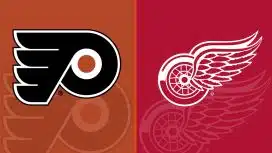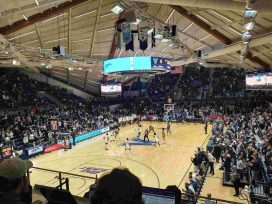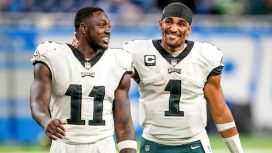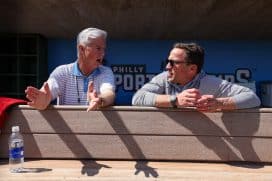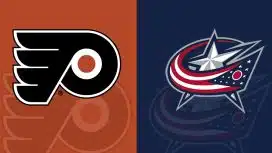Phillies
Phillies Nuggets: What should one make of Jorge Alfaro’s season thus far?
By Tim Kelly, Sports Talk Philly editor
"We have believers in Jorge Alfaro and we have people in our office who are not believers in Jorge Alfaro," said former Baseball America Editor John Manuel last July, just months before the Minnesota Twins hired him to be a pro scout.
Manuel's assessment of Alfaro, then at Triple-A, was fairly basic – the Twins didn't hire him because they were blown away by his thoughts on Alfaro. But with that brief statement on the Colombian-born catcher, Manuel summed up how conflicted the sport has felt (and in many cases, continues to feel) on Alfaro. His tremendous raw tools give him a high ceiling, though scouts around the sport have long been divided on whether Alfaro will put things together consistently at the major league level.
Nearly two months into his first full season at the major league level and Alfaro hasn't made the answer much clearer.
Well, that's not entirely true. He has answered one question: he's a catcher – one that has a chance to be pretty good at that. In Monday's win over the Atlanta Braves, Alfaro threw out one potential base stealer, a number that would have been higher had Scott Kingery held onto the ball at second base in the top of the first. The game concluded with Alfaro making a world-class throw that beat Ender Inciarte to first:
.@_JorgeAlfaro11 showed off his incredible arm on several different plays last night, including the final out of the game.
His manager made a bold comparison: https://t.co/Qv6IRAPSYV #ElOso pic.twitter.com/rbYUTXLe8F
— Philadelphia Phillies (@Phillies) May 22, 2018
After the game, Phillies manager Gabe Kapler compared him to his former Texas Rangers teammate, Hall of Fame catcher Ivan "Pudge" Rodriguez.
“I don’t know if there’s another catcher that I’ve ever seen — and I played with Pudge [Rodriguez] — that makes that play in the ninth inning,” Kapler told the collective media, which included Jim Salisbury of NBC Sports Philadelphia.
As noted by NBC Sports Philadelphia's Corey Seidman, Statcast says that Alfaro has demonstrated the strongest throwing arm of any catcher in the majors in 2018. He's one spot ahead of Gary Sanchez of the New York Yankees, who graded out as having the strongest throwing arm of any catcher in the majors in 2017. Alfaro has used that arm to throw out a league-leading eight runners thus far in 2018.
—
Of course, one of the few things people around baseball were sure about when evaluating Alfaro as a prospect was that his arm was going to play at the major league level, regardless of what position he played. Over a year before Kapler compared Alfaro to Rodriguez, his predecessor, Pete Mackanin, said Alfaro possessed the best arm that he had ever seen.
There were many who still weren't sure if Alfaro would make as a catcher. With his strong arm, the Phillies could have attempted to transition him into a corner outfielder, though it's difficult to imagine him being an effective outfielder given his build. Outfielders are much easier to come by than catchers as well. If Alfaro didn't work out behind the plate, the Phillies could have tried him at first, though as they learned with Tommy Joseph, a catcher that hits 25-30 home runs is significantly more valuable than a first baseman who does. Playing first base would also neutralize his strongest attribute, his throwing arm.
In any event, it doesn't appear the Phillies will have to cross that bridge. In addition to his strong arm, Alfaro's become a well-rounded catcher behind the plate. While he's allowed three passed balls this season, Alfaro has graded out at 16th best fielding catcher in the league this, per Baseball Prospectus. Alfaro continues to work on his pitch framing, as he's posted a 0.009 CSAA. (Baseball Prospectus says CSAA is "a measure of how many called strikes the player in question creates for his team.") 0.009 is a fairly average CSAA score – 16 catchers currently have a better score and six catchers are tied with Alfaro's CSAA. Still, league average, or just below league average, isn't a terrible place for Alfaro to be at this stage of his career.
Related: As Struggles Mount For Knapp, Backup Catcher Becoming A Need For Phillies
There are areas where Alfaro has graded out pretty well. FanGraphs says that he has a 3.2 dWAR, which isn't peak Carlos Ruiz good, but it's a mark that the Phillies certainly would have taken at the beginning of the season. Baseball Prospectus says that he's created 2.4 framing runs, which is 13th in the league and puts him on a pace that would be a vast improvement over Cameron Rupp. And after posting -5 defensive runs saved in 243.1 innings at the major league level in 2017, Alfaro has posted zero defensive runs saved in 266.1 innings in 2018.
The defensive runs saved statistic perhaps best exemplifies what Alfaro is as a catcher right now. While it's an improvement over the negative mark that he posted in 2017, zero is still zero. Alfaro hasn't cost the Phillies any runs thus far, but he also hasn't saved them. It's a relatively small sample size still, but Yadier Molina, long considered the gold standard behind the dish, averaged 16 defensive runs saved per season between 2005 and 2015. So for those ready to anoint Alfaro a gold glover based off of his arm, he's still a ways away, perhaps far enough that the idea of him being the best all-around fielding catcher in the National League at any point is a bit of a pipe dream. But it also speaks to the improvements that he's made behind the plate that it feels more likely now that Alfaro will fulfill his high ceiling behind the plate, rather than performing to the level of his low floor.
—
Let's start with this on Alfaro's offense: he's hitting .311 in May, 100 points higher than he hit in the month of April. That's encouraging. However, much of what Alfaro's shown offensively this season hasn't been encouraging.
At the time of this article's publication, Alfaro has struck out in over 39 percent of his plate appearances. Earlier this week, I was asked if the Phillies increased focus on seeing as many pitches per plate appearance as possible under Kapler has anything to do with the 47 strikeouts that Alfaro has in his first 119 plate appearances. There are a few Phillies who have seen increased strikeout rates in 2018 – Rhys Hoskins is striking out in 29 percent of his at-bats after doing so in under 22 percent of his at-bats in 2017; Cesar Hernandez is striking out in 21 percent of his at-bats after striking out in 18 percent in 2017.
Of course, things aren't that simple.
Pitchers have adjusted to Hoskins and his timing has been off of late. He's struck out 25 times this month because he's in the midst of the worst slump of his major league career, not because he's seeing more pitches in 2018. In fact, the 4.43 pitches-per-plate appearance that Hoskins is seeing in 2018 is actually slightly down from the 4.64 he saw a year ago. Hernandez is seeing slightly more pitches this year at 4.47 per-plate-appearance, but that's not a drastic increase from the over four pitches he saw every plate appearance a year ago.
So no, Alfaro's strikeout problems don't reflect poorly on Kapler or hitting coach John Mallee, they suggest that he's striking out at a rate that's not sustainable for a major leaguer. Like Hernandez, he's seen a small increase in pitches seen per plate appearance, but not such a large one that a trend like this could be attributed to it. Him striking out at an alarming pace is a him problem, one that he'll have to work on in conjunction with Kapler and Mallee. With two strikes, he's struggled against pretty much all pitches, the fourseam fastball, slider and curve.
Popular: At This Juncture, Would Reacquiring Cole Hamels Make Sense For Phillies?
The other issue is that while Hoskins and Hernandez are striking out at higher clips than they were a year ago, they've been valuable offensively in other ways. Hernandez has a league-leading 26-game on-base streak, largely because even when he's not hitting, his 32 walks have helped him to get on base. Of course, Hernandez is hitting .277, so he's getting on base with his bat too. Hoskins, mired in a prolonged slump, has seen his batting average dip to .237. But as we wait for his bat to come around, he's still walking, having worked 32 free passes this season as well.
Alfaro's biggest issue at the plate is that even the 60 percent of the time that he hasn't struck out this year, he hasn't been overly productive. Sure, he's hitting .311 this month, but he hit .211 in April. While Hoskins and Hernandez work walks even when they aren't hitting, Alfaro has just eight walks this year. This isn't a new trend – he walked just three times in 114 plate appearances last year, which followed him walking just 16 times in over 340 plate appearances at Triple-A.
His .418 BABIP also suggests that he hasn't run into issues of hitting the ball hard, but either right at fielders or to fielders that make tremendous plays to catch balls that normally would be hits. Carlos Santana's BABIP of .172 suggests he's been extremely unlucky in 2018. Alfaro's BABIP of .418 suggests that when he's put the ball in play, he's had tremendous success. He just isn't putting the ball in play regularly enough, which isn't surprising when he's striking out in two out of every five at-bats.
Like behind the plate, scouts weren't sure what to make of Alfaro as a hitter. They were sure that he had elite power potential for a catcher. Alfaro's one dominant trait behind the plate – his arm – has shined at the major league level. What was supposed to be his one dominant trait at the plate – his power – hasn't consistently appeared at the major league level yet. It's May 24 and Alfaro has four home runs, leaving Steamer to project that he'll hit just eight this season.
There are positive takeaways from Alfaro behind the plate thus far, but his -1.7 oWAR thus far in 2018 is among the numbers that suggest that Alfaro has a long way to go at the plate.
—
So what does it all mean? Rather simply, Alfaro has been impressive defensively. He's far from a finished product, but if it's possible, his arm has been even better than Mackanin suggested last Spring Training. Even beyond his arm, there's been a lot to like about Alfaro, who was acquired in the July 2015 Cole Hamels trade with the Texas Rangers, behind the plate.
At the plate, Alfaro's been frustrating. If he achieves his power potential, he can hit right around .250, especially if he's going to be a plus fielder. But he can't strike out 40 percent of the time that he bats, nor can he continue to walk in less than 10 percent of his plate appearances. One of the biggest tasks facing Kapler and Mallee is to help Alfaro reach his offensive ceiling.
It's been nearly 11 months since Manuel discussed how polarizing a prospect Alfaro was among those at Baseball America. He's no longer a prospect, but even after 229 games at the major league level, Alfaro's supporters can find reason to feel emboldened, while there's plenty for his detractors to pick at.
